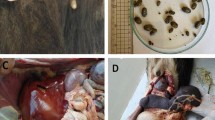Abstract
Molecular and histopathological studies were carried out on samples from three Brazilian dogs with persistent hepatozoonosis parasitemia. Canine hepatozoonosis was confirmed by finding gametocytes in blood smears. Histopathological examination of skeletal muscle biopsy revealed muscle degeneration and atrophy, and degenerating/regenerating myofibers, similar to the muscle degeneration caused by Hepatozoon americanum . However, the large cystic structures typical of H. americanum were not observed in muscle biopsies from these dogs. Partial 18S rRNA sequences amplified by PCR from the three Brazilian samples demonstrated closest similarity to the Hepatozoon sp. Fukuoka described in Japan (>99% identity). These results indicate that both additional clinical cases and genes need examination in order to determine the phylogenetic relatedness among canid Hepatozoon species.


Similar content being viewed by others
References
Baneth G, Weigler B (1997) Retrospective case-control study of Hepatozoonosis in dogs In Israel. J Vet Int Med 11(6):365–370
Baneth G, Barta JR, Shkap V, Martin DS, Macintire DK, Vincent-Johnson N (2000) Genetic and antigenic evidence supports the separation of Hepatozoon canis and Hepatozoon americanum at the species level. J Clin Microbiol 38(3):1298–1301
Baneth G, Mathew JS, Shkap V, Macintire DK, Barta JR, Ewing SA (2003) Canine Hepatozoonosis: two disease syndromes caused by separate Hepatozoon spp. Trends Parasitol 19(1):27–31
Ewing SA, Panciera RJ (2003) American Canine Hepatozoonosis. Clin Microbiol Rev 16(4):688–697
Gondim LFP, Kohayagawa A, Alencar NX, Biondo AW, Takahira RK, Franco SRV (1998) Canine Hepatozoonosis in Brazil: description of eight naturally occurring cases. Vet Parasitol 74:319–323
Inokuma H, Okuda M, Ohno K, Shimoda K, Onishi T (2002) Analysis of the 18S rRNA gene sequence of a Hepatozoon detected in two Japanese dogs. Vet Parasitol 106(3):265–271
Jain NC (1993). Essentials of veterinary hematology. Lea and Febiger, Philadelphia, 417pp
Macintire DK, Vincent-Johnson N, Kane CW, Lindsay DS, Blagburn BL, Dillon AR (2001) Treatment of dogs infected with Hepatozoon americanum: 53 cases (1989–1998). JAVMA 218(1):77–82
Mathew JC, Van Den Bussch RA, Ewing SA, Malayer JR, Latha BR, Panciera RJ (2000) Phylogenetic relationships of Hepatozoon (Apicomplexa: Adeleorina) based on molecular, morphologic, and life-cycle characters. J Parasitol 86(2):366–372
Murata T, Makoto I, Taura Y, Nakama S, Abe H, Fujisaki K (1995) Detection of Hepatozoon canis oocyst from ticks collected from the infected dogs. J Vet Med Sci 57(1):111–112
O’Dwyer LH, Massard Cl, Souza JCP (2001). Hepatozoon canis infection associated with dog ticks of rural areas of Rio De Janeiro State, Brazil. Vet Parasitol 94:143–150
O’Dwyer LH, Saito ME, Hasegawa MY, Kohayagawa A (2004). Tissue stages of Hepatozoon canis in naturally infected dogs from São Paulo State, Brazil. Parasitol Res 94:240–242
Paludo GR, Dell’Porto A, Trindade ARC, McManus CM, Friedman H (2003) Hepatozoon spp: report of some cases in dogs in Brasília, Brazil. Vet Parasitol 118:243–248
Panciera RJ, Ewing SA, Mathew JS, Cummings CA, Kocan AA, Breshears MA, Fox JC (1998) Observations on tissue stages of Hepatozoon americanum in 19 naturally infected dogs. Vet Parasitol 78:265–276
Vincent-Johnson N, Macintire DK, Baneth G (1997) Canine Hepatozoonosis: Pathophysiology, diagnosis, and treatment. Small Anim 19(1):51–62
Acknowledgements
Maria Aparecida Ramos Castro kindly allowed the use of her three dogs for this work. This project was supported by Conselho Nacional de Desenvolvimento Cientifico e Tecnologico—CNPq (Brazil), Auburn University ICRE funds, and by the Auburn University Scott Ritchey Foundation. The experiments comply with current laws of Brazil and the USA.
Author information
Authors and Affiliations
Corresponding author
Rights and permissions
About this article
Cite this article
Paludo, G.R., Friedmann, H., Dell’Porto, A. et al. Hepatozoon spp.: pathological and partial 18S rRNA sequence analysis from three Brazilian dogs. Parasitol Res 97, 167–170 (2005). https://doi.org/10.1007/s00436-005-1419-2
Received:
Accepted:
Published:
Issue Date:
DOI: https://doi.org/10.1007/s00436-005-1419-2




